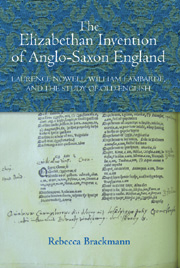 The Elizabethan Invention of Anglo-Saxon England
The Elizabethan Invention of Anglo-Saxon England Book contents
- Frontmatter
- Contents
- List of Illustrations
- Dedication
- Acknowledgements
- Chapter 1 The Anglo-Saxonists and Their Books: Print, Manuscript, and the Circulation of Scholarship
- PART I ANGLO-SAXON TEXTS AND SIXTEENTH-CENTURY ENGLISH
- PART II CHOROGRAPHIES AND THE PAST OF ENGLAND
- Chapter 4 Somewhere in Time: The Abcedarium Place-Name Index
- Chapter 5 Putting the Past in Place: Lambarde's Alphabetical Description and Perambulation of Kent
- Chapter 6 Images and Imaginings of England
- PART III OLD ENGLISH AND THE COMMON LAW
- Conclusion: The Invention of Anglo-Saxon England
- Bibliography
- Index
- Title in the Series
Chapter 6 - Images and Imaginings of England
from PART II - CHOROGRAPHIES AND THE PAST OF ENGLAND
Published online by Cambridge University Press: 05 February 2013
- Frontmatter
- Contents
- List of Illustrations
- Dedication
- Acknowledgements
- Chapter 1 The Anglo-Saxonists and Their Books: Print, Manuscript, and the Circulation of Scholarship
- PART I ANGLO-SAXON TEXTS AND SIXTEENTH-CENTURY ENGLISH
- PART II CHOROGRAPHIES AND THE PAST OF ENGLAND
- Chapter 4 Somewhere in Time: The Abcedarium Place-Name Index
- Chapter 5 Putting the Past in Place: Lambarde's Alphabetical Description and Perambulation of Kent
- Chapter 6 Images and Imaginings of England
- PART III OLD ENGLISH AND THE COMMON LAW
- Conclusion: The Invention of Anglo-Saxon England
- Bibliography
- Index
- Title in the Series
Summary
Nowell's maps offer us a chance to see, quite literally, his idea of England and his associated desires for his Anglo-Saxon research. Even though some of his maps do not directly participate in his Anglo-Saxon studies, they were probably related, as F.J. Levy argues:
Nowell, for all that he knew Parker and Joscelyn, was working along the lines laid down by Leland rather than those of the archbishop. The restoration of Old English was intended to aid in producing a historical topography of the country: Nowell's activities in mapping England presumably supplied the necessary geographical information.
Viewing Nowell's maps as merely background for his place-name research, however, misses their own nationalistic agenda and claims, claims crucial to his very idea of what England was, what it wasn't, and what he wanted his medieval studies to accomplish. Although considering his maps may seem a departure from studying the Abcedarium and his other Old English materials, such an examination reveals important, but overlooked, evidence of Nowell's broader cultural context and aims. The maps not only show us how he saw England and Ireland, but also how he viewed the past and the present, and how those categories, seemingly separate, became reinforcing. This has repercussions for all aspects of his Anglo-Saxon research beyond just chorography, as it gives us a framework for his linguistic and legal studies as well.
- Type
- Chapter
- Information
- The Elizabethan Invention of Anglo-Saxon EnglandLaurence Nowell, William Lambarde, and the Study of Old English, pp. 148 - 186Publisher: Boydell & BrewerPrint publication year: 2012


